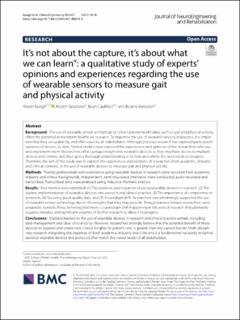| dc.description.abstract | Background
The use of wearable sensor technology to collect patient health data, such as gait and physical activity, offers the potential to transform healthcare research. To maximise the use of wearable devices in practice, it is important that they are usable by, and offer value to, all stakeholders. Although previous research has explored participants’ opinions of devices, to date, limited studies have explored the experiences and opinions of the researchers who use and implement them. Researchers offer a unique insight into wearable devices as they may have access to multiple devices and cohorts, and thus gain a thorough understanding as to how and where this area needs to progress. Therefore, the aim of this study was to explore the experiences and opinions of researchers from academic, industry and clinical contexts, in the use of wearable devices to measure gait and physical activity.
Methods
Twenty professionals with experience using wearable devices in research were recruited from academic, industry and clinical backgrounds. Independent, semi-structured interviews were conducted, audio-recorded and transcribed. Transcribed texts were analysed using inductive thematic analysis.
Results
Five themes were identified: (1) The positives and negatives of using wearable devices in research, (2) The routine implementation of wearable devices into research and clinical practice, (3) The importance of compromise in protocols, (4) Securing good quality data, and (5) A paradigm shift. Researchers overwhelmingly supported the use of wearable sensor technology due to the insights that they may provide. Though barriers remain, researchers were pragmatic towards these, believing that there is a paradigm shift happening in this area of research that ultimately requires mistakes and significant volumes of further research to allow it to progress.
Conclusions
Multiple barriers to the use of wearable devices in research and clinical practice remain, including data management and clear clinical utility. However, researchers strongly believe that the potential benefit of these devices to support and create new clinical insights for patient care, is greater than any current barrier. Multi-disciplinary research integrating the expertise of both academia, industry and clinicians is a fundamental necessity to further develop wearable devices and protocols that match the varied needs of all stakeholders. | en_US |

